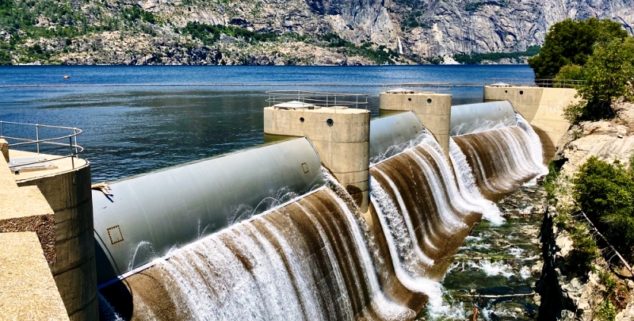Opinion
Dams, a key part of state infrastructure, must be kept safe
 O'Shaughnessy Dam in Hetch Hetchy Valley, Yosemite National Park, is a key source of water to the SF Bay Area. (Photo: SveKo, via Shutterstock)
O'Shaughnessy Dam in Hetch Hetchy Valley, Yosemite National Park, is a key source of water to the SF Bay Area. (Photo: SveKo, via Shutterstock)We applaud Gov. Gavin Newsom and the Legislature for taking bold action last year to fund climate resilience and related water infrastructure in the fiscal year 2021-’22 state budget. In light of the current budget surplus, funding for climate resilience and water infrastructure should remain a key priority for investment in California.
Dedicating a small fraction of the state’s budget surplus dollars for safety and climate resilience projects at existing dams in the state budget would be a prudent step for the governor and Legislature.
The state is already on notice of dam safety risks in California. In a report released in 2019 regarding high risks in California, the State Auditor reported that aging dams that are classified as having high or extremely high downstream hazard potential are those for which failure would result in potential loss of life, environmental damage and economic loss. Some of the dams need seismic retrofits so that they will not be vulnerable to full or partial failure in the event of a major earthquake.
Due to the concerns regarding public safety, water managers are having to operate many existing reservoirs at levels significantly below their full design capacity.
State funding assistance for public safety makes sense. Indeed, the state auditor noted in the High Risk report released in 2020 that “there are no state‑level programs that provide financial assistance to dam owners for repairing the dams and resolving deficiencies. Until an avenue of funding becomes available to facilitate repairs and improvements to high‑risk dams, the water infrastructure in the state will continue to pose a significant risk.”
Local and regional water agencies and their customers will do their part to fund these projects, but dam safety projects are expensive and provide benefits beyond water management. The cost for one project is often in the hundreds of millions dollars. President Joe Biden and Congress approved a modest amount of federal funding this year for dam safety, and state funding assistance is needed.
Due to the concerns regarding public safety, water managers are having to operate many existing reservoirs at levels significantly below their full design capacities. This reduces risk but also reduces their ability to store water during wet periods for times when it is needed, like now during the drought. This is why investment in dam safety makes sense in terms of climate resilience.
February marked the fifth anniversary of the Oroville spillway emergency. Most of California’s major dams are older than Oroville Dam, with a median construction date of 1955. The improvements needed to enhance public safety at existing dams and fully restore water storage capacity would include repairs, reinforcements, and seismic upgrades, as well as construction of new spillways. These spillways would give dam operators greater flexibility in holding water for storage or releasing water to prevent floods – two actions that are critical to ensure that these existing dams can meet the extremes of our changing climate. This type of modern water management can result in significant volumes of water being saved during wet times so that it is available for use in dry times.
With another year of state budget surplus, the time is right for funding state grants for dam safety projects within the Fiscal Year 2022-23 state budget. The grants would help make possible projects that would enhance public safety, improve water storage, and result in better climate resilience and new jobs for California. Our organizations urge Governor Newsom and the Legislature to include funding for dam safety grants in the Budget for Fiscal Year 2022-’23. The Legislature’s June 1 budget proposal, which includes some funding for dam safety, is a good starting point for discussion. Our organizations suggest between $500 and $800 million for this category. The need for assistance is much greater.
—
Editor’s Note: Dave Eggerton is executive director of the Association of California Water Agencies and can be reached at [email protected]. Michael Quigley is executive director of the California Alliance for Jobs and can be reached at [email protected].
Want to see more stories like this? Sign up for The Roundup, the free daily newsletter about California politics from the editors of Capitol Weekly. Stay up to date on the news you need to know.
Sign up below, then look for a confirmation email in your inbox.

Leave a Reply